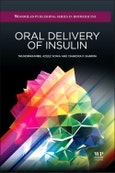Diabetes Mellitus, a syndrome of disordered metabolism, characterised by abnormal elevation in blood glucose level, has become a life-threatening condition for many people. Current means of therapy for Diabetes Mellitus do not mimic the normal physiological pattern of insulin release. Oral delivery is the preferred route of administration due to its non-invasive nature. Oral delivery of insulin presents an overview of Diabetes Mellitus, and discusses the strategies and techniques adopted for oral delivery of insulin. This title begins with an introductory chapter on symptoms, complications and therapy for Diabetes Mellitus. Subsequent chapters cover the various routes for administering insulin; the challenges and strategies of oral delivery; experimental techniques in the development of an oral insulin carrier; lipids; inorganic nanoparticles and polymers in oral insulin delivery; and a summary and presentation of future perspectives on oral delivery of insulin.
Table of Contents
- List of figures and tables
- Figures
- Tables
- About the authors
- 1: Diabetes mellitus
an overview
- Abstract
- 1.1 Diabetes mellitus an introduction
- 1.2 Glucose homeostasis
- 1.3 Types of diabetes
- 1.4 Symptoms of diabetes
- 1.5 Complications of diabetes
- 1.6 Diagnosis of diabetes mellitus
- 1.7 Therapy for diabetes
- 1.8 Non-insulin treatment options of type 1 diabetes
- 1.9 Treatment options of type 2 diabetes
- 1.10 Conclusion
- 2: Routes of administration of insulin
- Abstract
- 2.1 Current approach for the delivery of insulin
- 2.2 Routes of administration of insulin
- 2.3 Conclusion
- 3: Oral insulin delivery
challenges and strategies
- Abstract
- 3.1 Oral delivery of insulin
- 3.2 Barriers to oral delivery of insulin
- 3.3 Strategies and alternatives to improve oral insulin delivery
- 3.4 Conclusion
- 4: Experimental techniques involved in the development of oral insulin carriers
- Abstract
- 4.1 Introduction
- 4.2 Polymeric nanoparticles
- 4.3 Physicochemical characterization of nanoparticles
- 4.4 Biological evaluation
- 4.5 In vitro method for assessing drug permeability
- 4.6 In vivo study of oral insulin
- 4.7 Biodistribution studies
- 4.8 Conclusion
- 5: Lipids and inorganic nanoparticles in oral insulin delivery
- Abstract
- 5.1 Lipid-based systems for oral delivery of insulin
- 5.2 Liposomes
- 5.3 Solid lipid nanoparticles
- 5.4 Nanostructured lipid carriers
- 5.5 Niosomes
- 5.6 Archaeosomes
- 5.7 Cubic nanoparticles (cubosomes)
- 5.8 Aquasomes
- 5.9 Inorganic nanoparticles as carriers for oral insulin delivery
- 5.10 Conclusion
- 6: Polymers in oral insulin delivery
- Abstract
- 6.1 Introduction
- 6.2 Characteristics of an ideal oral insulin carrier
- 6.3 Polymers in oral insulin delivery
- 6.4 Natural polymers
- 6.5 Synthetic polymers
- 6.6 Conclusion
- 7: Summary and future perspectives for oral insulin delivery
- Abstract
- 7.1 Introduction
- 7.2 Technologies developed for clinical applications of oral insulin delivery
- 7.3 Conclusions and future perspectives
- Index








